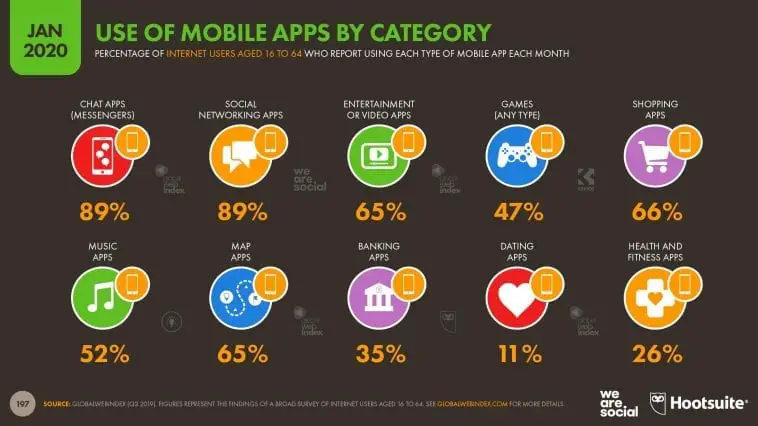(Source: We Are Social)
Mobile app usage has increased tremendously in the United States. The Coronavirus pandemic can be attributed as one of the reasons, with people having limited options for engagement.
In this article, we’ll look at key mobile app statistics for the US for the year 2020. We’ll start each segment with a general outlook and follow it up with US-focused statistics. This should give you a good measure to compare US mobile app statistics with the rest of the world.
We will consider different aspects of mobile apps, which include the following sections:
- Mobile penetration & app downloads
- Usage
- Performance
- Industry vertical focused
- Revenue generated
Let’s get started.
1. Mobile penetration & mobile app downloads statistics
There are 3.5 billion smartphone users in the world today. That’s penetration of 45.4% of the entire global population. Mobile app download has been pretty high this year, as well, with over 130 billion app downloads.
The higher the mobile penetration rate of a country, the more downloads, usage, and revenue such a country will generate. Understanding the mobile penetration & download rate in the United States can help brands know which markets to focus on.
· 76% of adults in the US have access to mobile phones and apps
Advanced economies like the United States have a very high mobile penetration rate. Almost 76% of the adult American population use smartphones and mobile apps. This is predominantly due to the higher standard of living and better access to living facilities, compared to emerging countries like India, Nigeria, etc.
· Rural Americans are 10X less likely to have access to the internet
Surprisingly, rural America and citizens living on tribal lands are still in the digital dark. According to a Pew Research Center survey, only 63% of rural Americans stated they had a broadband connection at home.
This automatically translates to a much lower mobile app download/usage rate for rural Americans due to the non-availability of proper internet connectivity.
· Over 51% of all mobile app users in the US don’t download apps
While US smartphone users do use mobile apps, most don’t download apps regularly. 13% of the US population downloads only one app per month. And only 5% of the population downloads more than eight apps per month.
In comparison, China saw app download rates increase by 80%, while India experienced historic app download rates at 190% compared to 2019.
· 13% of US citizens are willing to install covid19 tracking apps by federal agencies
In a poll of Democrat and Republican Americans, it was found that 62% and 61% of the respective populations were willing to download covid19 tracking apps this year. But 13% of the population stated that they would download and use such an app only if the app was developed by a federal agency.
Remarks: As seen, mobile penetration has been very high in the US in 2020, but predominantly in the Urban sections of the country. While mobile app usage is high, Americans don’t actively download or purchase multiple apps, choosing instead to extensively use the apps they already have.
2. Mobile app usage statistics
Mobile internet traffic globally has increased by 30% in 2020, and most of this traffic is towards mobile apps. Take a look at the table below:
| Increase in app usage by country | |||
| Country | 2017 to 2019, daily mobile hours | 2019 to Q2 2020, daily mobile hours | Q4 2019 to Q2 2020, monthly app hours |
| China | 60% | 15% | |
| India | 25% | 37% | 30% |
| France | 25% | 17% | 20% |
| Canada | 25% | 39% | |
| Indonesia | 20% | 27% | 25% |
| Brazil | 15% | 28% | 20% |
| Japan | 15% | 12% | 15% |
| United Kingdom | 15% | 14% | 15% |
| South Korea | 15% | 5% | |
| Germany | 15% | 10% | |
| United States | 10% | 10% | 15% |
| Russia | 10% | 40% | 15% |
| Italy | 27% | 30% | |
| Spain | 25% | 30% |
(Source: Business of Apps)
Now let’s take a detailed look at how the US fares.
· Americans spend 88% of their phone time on apps
The average American spends a minimum of 4 hours each day on mobile internet. Of this, 88% of their time is spent on using apps. The average mobile app user in the US uses ten apps each day and over 30 apps each month.
This usage rate is expected to increase in 2021.
· YouTube was the most-accessed and most-used mobile app in 2020
72.8% of all mobile users in the United States used YouTube extensively in 2020 to consume content. Following this was Facebook, at a 72% usage rate. This was followed by gaming and entertainment apps used extensively during the country-wide social distancing and lockdown implementation. In terms of work-related usage, Gmail remained the most popular mobile app with a 55.8% usage rate.
· Google Maps was the most-used app in September 2020
Many states across the US started easing lockdown restrictions from mid-year 2020. It’s no wonder that Google Maps became the most-accessed mobile app in September 2020, with 54.7% of the population using the mobile app.
· Colorado has the highest mobile internet and app usage rate, while North Carolina has the lowest
88.2% of Colorado’s residents use mobile apps and mobile internet, compared to North Carolina’s 74.3% usage rate. On average, the United States, as a whole, has a mobile app usage rate of 79.4%. Surprisingly, states like New York and California come in the 15 states with the lowest mobile app usage rates in the country.
Remarks: Americans have spent a large amount of time on mobile apps in 2020. But, not every state in the US has been equally enthusiastic about mobile app usage. Of those who did use apps, video apps like YouTube have ruled the roost around the year. But immediately after lockdown restrictions were eased, map apps have gained ground as people began to travel.
3. Mobile app performance statistics
Mobile app performance is instrumental to the success of the app. For example, did you know that app users worldwide want their mobile apps to load within 2 seconds? If this doesn’t happen, there’s a risk they’ll move to another app.
In addition to app load speed, bugs, crashes, app malware, and security concerns all affect how often mobile apps are used and recommended to others by users.

(Source: Now Secure)
Here’s what we need to know about the impact of mobile app performance on Americans:
· 44% of all in-app problems and bugs are found by users and not developers
Contrary to assumption, it isn’t app developers in the US who discover bugs in apps. 44% of all mobile app issues are identified and highlighted by users.
· 32.87% of all global mobile attacks happened in the United States
Mobile app security is an issue in the US. Over 32.87% of all mobile threats and attacks occurred in the US in 2020. Of this, 0.10% of all attacks were ransomware trojans. This type of performance issue indicates poor mobile app security in the US.
· 62% of US mobile app users uninstall apps that crash or malfunction
The average crash rate for mobile apps in the US is 1%-2%. But despite such a low crash figure, American mobile app users can be unforgiving. Over 62% of users choose to uninstall the app and switch to a different one if they experience bugs or crashes often.
Remarks: Mobile app users in the US hold their apps and developers to very high standards. They are much less forgiving when it comes to faulty apps that don’t perform well. One of the primary reasons for app uninstalls in the US have been poor app security, a high number of bugs, and crashing.
4. Industry-focused mobile app statistics
In 2020, apps from the social & communication industry (ex: Instagram, TikTok & Facebook), messaging (ex: WhatsApp), writing & note-taking (ex: Journey & Evernote), drawing (ex; Procreate Pocket), gaming (ex: PUBG & Game of Thrones), music (ex: Shazam) and fitness (ex: NRC & Pumatrac) have been gaining popularity around the world.

(Source: InMobi)
In the US too, these industries are some of the top-performing industries in terms of mobile app download/usage in 2020. Other industry-specific apps that are making big waves in America are:
· Government and health apps gained the highest usage
During the coronavirus pandemic, 44.9% of all mobile web and app usage was directed towards government/legal apps. Around 54.9% of all mobile app and web traffic headed towards health and fitness platforms.
· Demand for mobile banking has increased by 50%
According to FBI reports, the demand for mobile banking apps has increased by 50% in the US. This was particularly after the covid19 lockdown when access to ATMs and banks was restricted.
On average, Americans spend 3.1 minutes on banking and fintech apps.
· Business for food delivery apps in the US has doubled in 2020
Uber Eats, GrubHub, DoorDash, and Postmates (prior to its acquisition by Uber) have collectively raked in over $5.5 billion in revenue in 2020. This is almost twice the value of their September 2019 revenues of $2.5 billion. In the same vein, restaurant table booking apps and platforms like OpenTable have seen a decrease in usage.
The coronavirus pandemic has increased demand for food delivery apps tremendously, and the number of food delivery app downloads have increased significantly too.
· 35% of all retail app users in the US are over 55 years old
Retail apps such as Amazon, Walmart, Target, Etsy, and Best Buy, to name a few, have become more popular in 2020 in the US.
While 35% of all retail downloads were don by the over-55 age group, 22% of downloads were from the 46-55 age group, and 20% from the 26-35 age group. 61% of this overall app installer population were white/Caucasian, and 55% were women.
In terms of income bracket, 2/3rd of all retail mobile app users belong to middle-income families earning approximately $75,000 a year.
Remarks: Mobile apps across industries have performed tremendously well in the US in 2020. The coronavirus pandemic, while having a very negative effect on physical stores, has allowed for mobile app dependency to grow in the country.
5. Mobile app revenue statistics
Although 92% of all Apple App Store apps and 96% of all Google Play Store are free, global mobile app revenues grew by 32% YOY in 2020. Apple App Store saw its Q3 2020 rake in $19 billion in revenue, while Google Play Store earned $10.3 billion in revenue during the same period. Total spending on paid mobile apps reached $29.3 billion this year.

(Source: Sensor Tower)
Of this revenue, two mobile apps that have been consistently on the top revenue-generating list for both Android and Apple devices have been YouTube (paid, ad-free subscription) and Netflix. But apart from these, 2020 has seen other apps performing very well in the US:
· Coin Master brought in $62.9 million revenue for Google in the US
The Coin Master game app outperformed many other apps in the US. After Coin Master, all the other apps with high revenues were gaming apps, such as Pokémon Go, Candy Crush Saga, Gardenscapes, Homescapes, Dragon Ball Z, etc. The only non-gaming app on this list was Pandora, the music & podcast streaming app. It performed last in the Top 10 highest-earning Android apps at $13.16 million.
· Apple received over $18.33 million in revenue from Disney+
Video streaming app Disney+ was the clear winner revenue-wise on the Apple App Store. After this on the list was dating app Tinder, which brought in a revenue of $17.36 million. Video conferencing app Zoom earned 4X more than it did last year, as the demand for virtual meeting platforms increased due to the coronavirus.
· Subscription-based apps are one of the highest-earning apps of 2020
Apps offering subscription-based services (ex: New York Times, Medium, Curiosity Stream, etc.) were the top purchased apps in the US, outside gaming apps. They were seen earning 2-3 times more than apps that used in-app advertisement and having revenues 50% more than apps that had in-platform purchases. This earning accounted for 19% of total mobile app revenue generated by US customers.
Remarks: The US has been one of the largest contributors to mobile app revenue growth in 2020. This trend is expected to continue going into 2021. The United States, along with the United Kingdom, China, South Korea, and Japan is expected to account for 85% of mobile revenues next year.
Conclusion
Mobile apps have a very bright future in the United States, with more people choosing to use mobile apps over website browsers. In fact, trends indicate that spending on mobile apps may reach $139 billion in 2021. Companies that plan to release mobile apps in the US can do so, secure in the knowledge of their high-potential to earn revenue.



